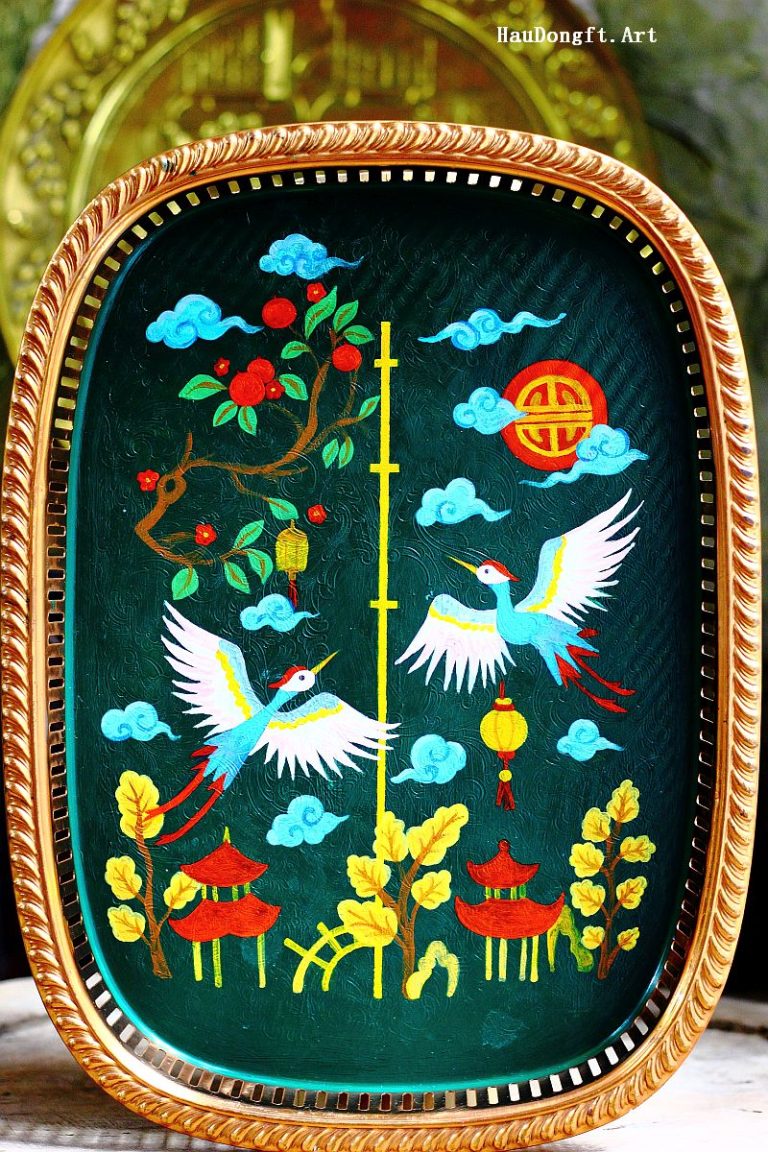
1. The Rank of Great Mandarins
The costumes comprise five colors: a red robe for the First Mandarin, a blue robe for the Second Mandarin, a white robe for the Third Mandarin, a yellow robe for the Fourth Mandarin, and a light-blue robe for the Fifth Mandarin. These robes are embroidered with dragons, waves, or woven brocades with dragon motifs. On the head, the mandarin wears a folded turban, adorned with hairpins and combs, with a horizontal stripe matching the robe’s color. A ritual tablet is fastened on the chest, while the waist is girdled with a belt embroidered with the “four sacred creatures” (tứ linh). If wearing a brocade robe, an additional dragon sash is draped over the shoulder, with a silk waistband tied loosely. In some cases, a red robe for Mandarin Điều Thất or a yellow robe for Mandarin Triệu Tường is used when the higher-ranked mandarins’ costumes are not borrowed. The Great Mandarins, Princes, and Holy Pages use red incense-offering turbans embroidered with dragons when officiating in ritual ceremonies.
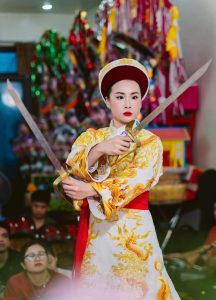
The 3rd Mandarin in a sword dance
2. The Rank of Dames (Chầu Bà)
Their costumes are embroidered with floral and phoenix motifs, or brocades woven with phoenixes and flowers. The 1st Dame wears a red robe with a red scarf; the 8th Dame wears white with a white scarf; rhe 4th Dame wears yellow with a yellow scarf. As a royal envoy of the Four Palaces, the 4th Dame may also don all four colors—red, blue, white, and yellow—symbolizing her ability to traverse all palaces.
The Dames of the Mountain Palaces (Thượng Ngàn) wear green, sky blue, indigo, or ochre robes: for instance, the 2nd Dame wears leaf-green, the 5th Dame wears sky blue, the 6th Dame wears light blue, the 10th Dame wears indigo or yellow, and the little Dame wears a light green four-panel robe with a dark-blue turban. These Dames often wear turbans tied in the “water chestnut” style, silver necklaces, silver earrings, and shoulder sashes embroidered with phoenixes. A cross-belt girdle, a curved ritual knife (dao quắm), a betel pouch, and a set of silver chains (xà tích) complete their attire.
Traditionally, Dames did not wear black skirts or leg wrappings as today. Those were typically worn only when manifesting as Mountain Nymphs (Thánh Cô Thượng Ngàn). However, in modern practice, mediums add these garments to enrich the costumes and highlight the graceful beauty of the Dames. In some manifestations, they also wear regional attire—conical or gong-shaped hats, leg wrappings—evoking the identity of Vietnam’s ethnic minorities, emphasizing the bond between different ethnic groups through the imagery of the mountain deities.
For example, in the manifestation of Goddess Thác Bờ (associated with the Mường people of Hòa Bình), the medium wears a short white blouse, pink halter, blue waistband, black skirt, ethnic brocade sash, silver ornaments, and a white Mường-style turban. The 8th Dame, a female general of the Trưng Sisters, is represented in a yellow robe with turban, sword, and flag, embodying heroism and martial spirit.
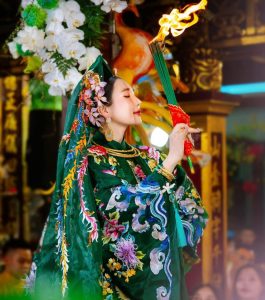
The 2nd Dame in a torch dance
3. The Rank of Princes (Quan Hoàng)
Representing the Four Palaces, there are ten princes. Commonly manifested ones include: Prince Hoàng Bơ in a white robe with golden sash, Prince Hoàng Bảy in blue with green sash, Prince Hoàng Mười in yellow with red sash, or the elder Lords Ong Nhất in red and Ong Đôi in blue. Their costumes are usually brocade robes with dragon medallions, longevity motifs, or swirling cloud patterns. Embroidered versions feature dragons and waves, with dragon medallions across the robe. Two sashes cross over the shoulders, golden necklaces with coin pendants hang from the neck, silk belts gird the waist, and folded turbans embroidered with dragons match the robe color. Hairpins and combs are worn in the masculine style, with roses tucked by the ear for elegance.
4. The Rank of Maiden Spirits (Thánh Cô)
Their costumes, resembling those of the Dames, can be brocade or embroidered robes, with a wide variety of styles. Representative examples include: the 1st Princess in a red long dress, Princess Bơ ( the 3rd Princess) in a white long dress, and the 9th Princess in a pink long dress with turban. The turban stripes match the robe’s color, though Princess Bơ sometimes wears a tricolor band or floral fabric braids. Accessories may include small shoulder sashes, necklaces, silk belts, and floral hair ornaments.
In some manifestations, such as Princess Bơ, the medium wears a three-colored four-panel robe with a black skirt, an inner blouse, pink halter, bead necklace, turban styled in the “ponytail wrap,” tortoiseshell or ivory combs, and white flower ornaments, creating a demure and graceful image.
Mountain Maidens (Thượng Ngàn) wear short brocade blouses, skirts, leg wrappings, and ethnic-style turbans. Examples include: the 2nd Princess in a green blouse, the 6th Princess in a light-blue blouse with wide sleeves, the 8th Princess carrying a tea basket in Mường-style attire of Thanh Hóa, and the little Princess with playful costumes, ranging from blue or black robes to leaf costumes of red and green, complete with bows, flower baskets, silver jewelry, and colorful sashes.
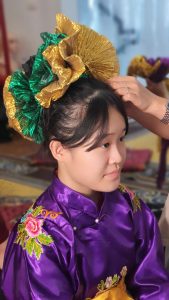
Me as the Little Princess
5. The Rank of Holy Pages (Thánh Cậu)
Their attire is simpler: a short military-style robe, crossed turban or hat, small shoulder sashes, silver necklaces, fabric flower ornaments on the arms, and jingling anklets. Belts are tied with short and long sashes hanging stylishly at the side. The 1st Page wears red, the 2nd Page wears blue, Page Bơ (the 3rd Page) wears white, and the Little Page may wear green or yellow. Their robes may be brocade with floral or longevity motifs, or embroidered with dragons and the four noble plants.
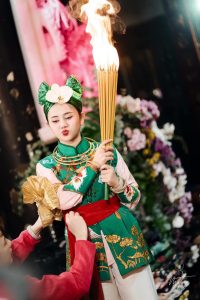
The Little Page
Through this overview, we see the extraordinary richness and diversity of ritual costumes in the Mother Goddess worship tradition. The attire reflects courtly garments as well as regional and ethnic identities, underscoring the cultural depth of the lên đồng ritual. It is important that mediums preserve the traditional beauty of these costumes while adapting them to contemporary aesthetics, ensuring that the sacred, cultural, and artistic values of the Mother Goddess worship are maintained and celebrated.
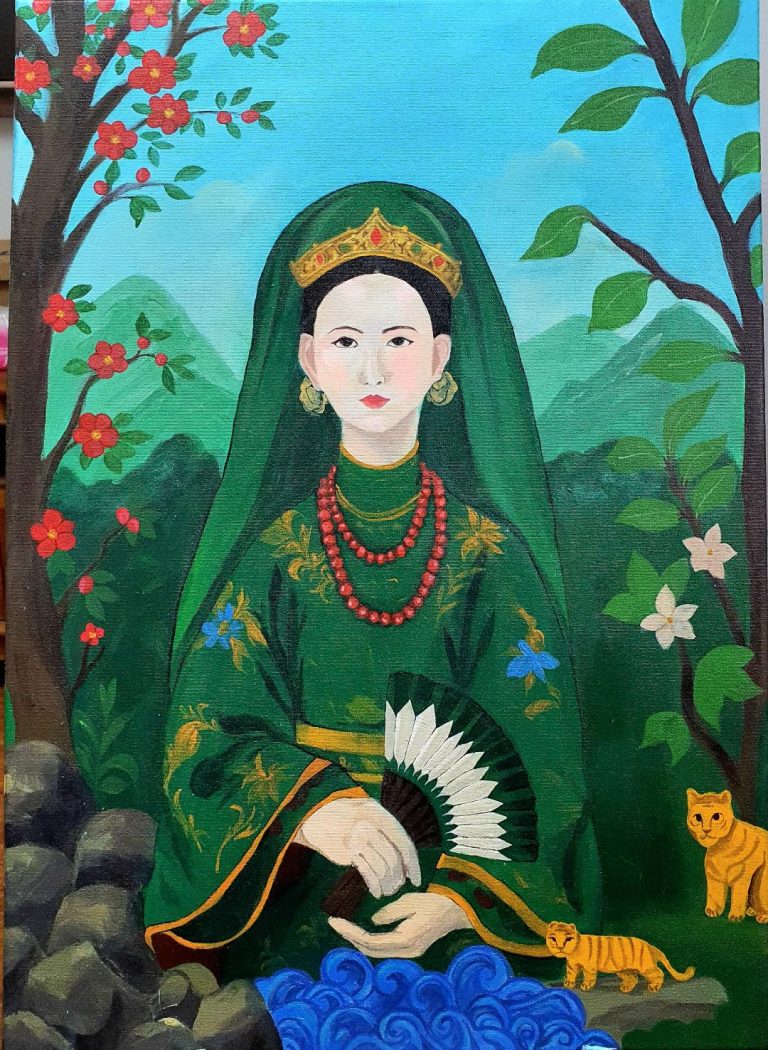
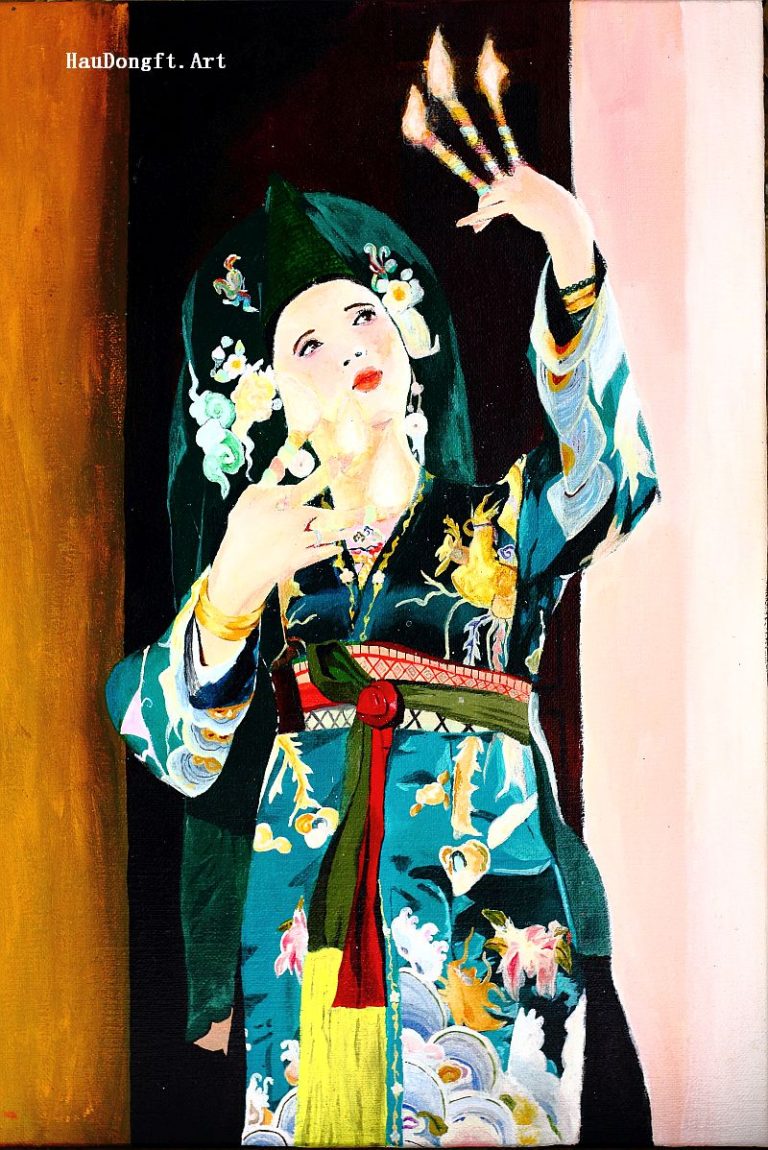


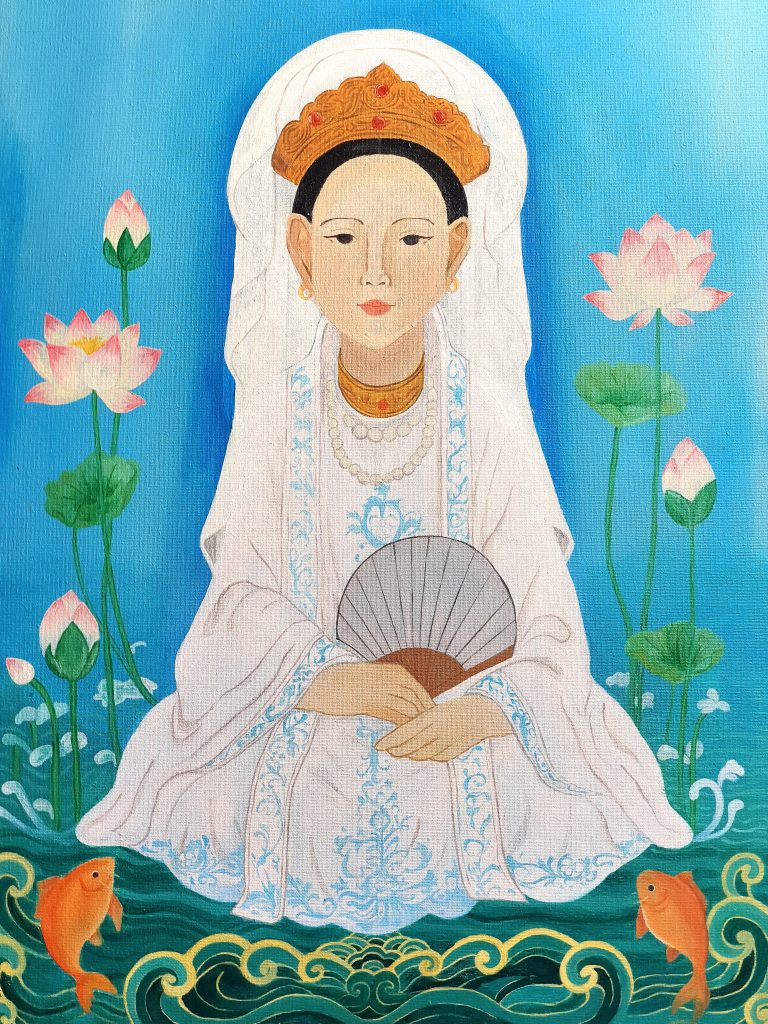


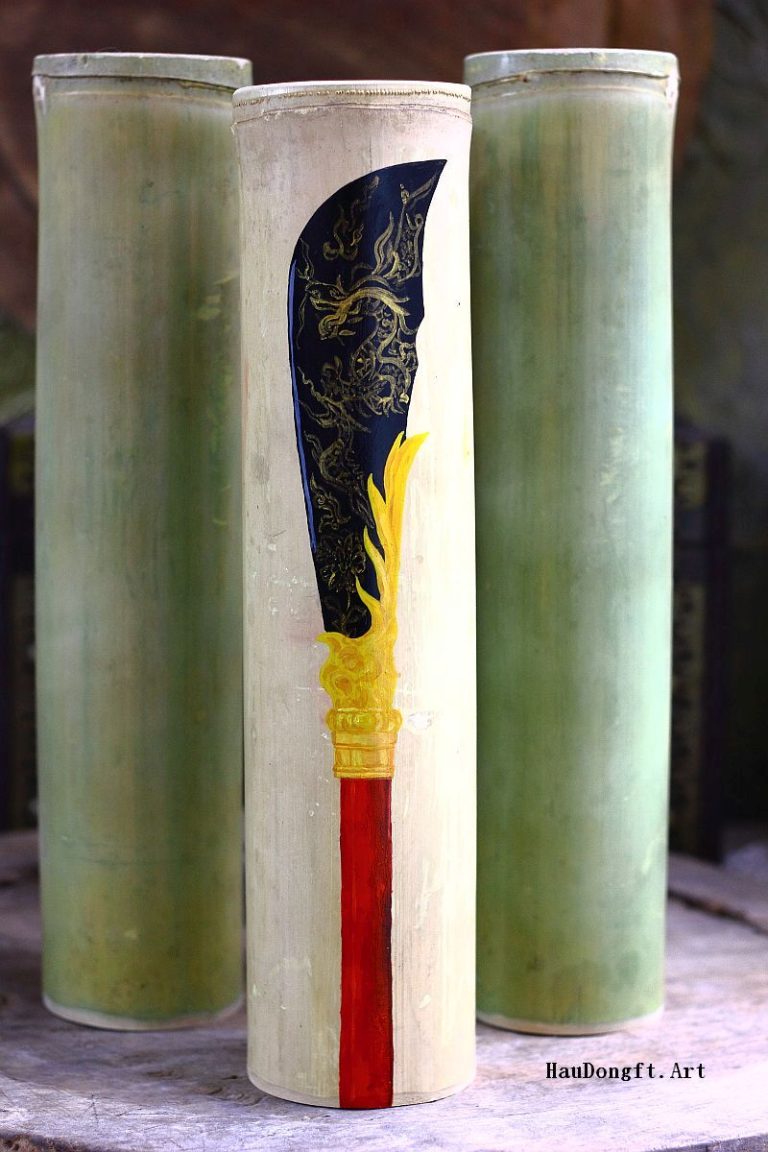
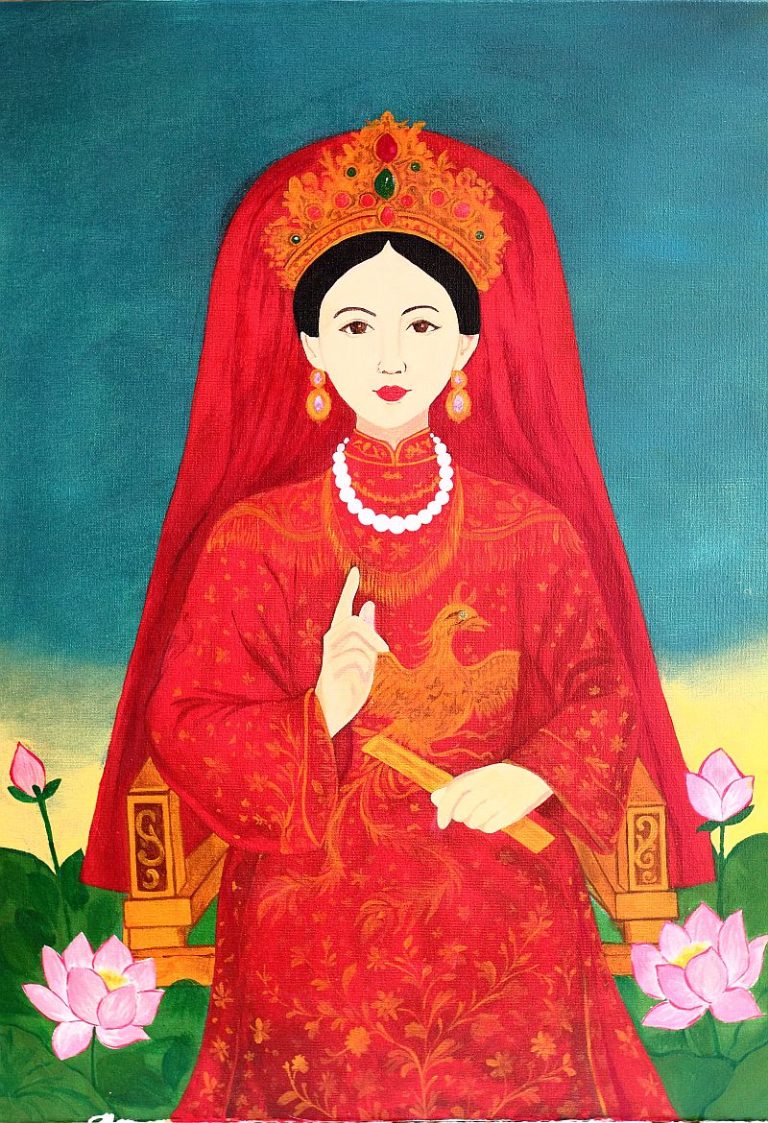

© 2025 Hau Dong Featuring Art. All rights reserved. Contact